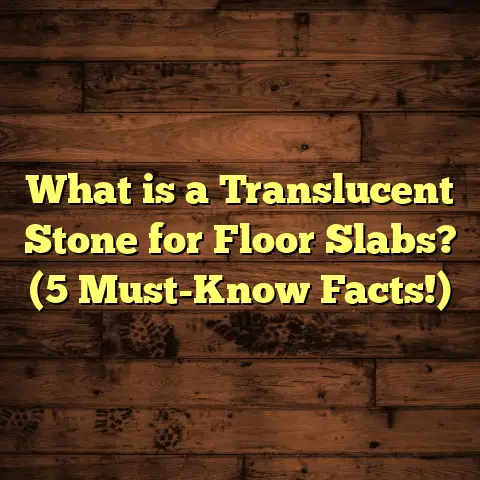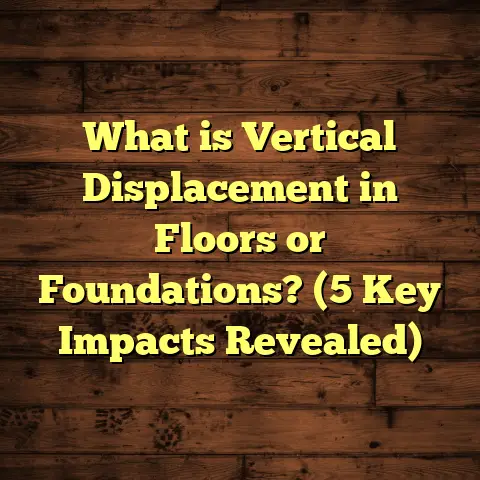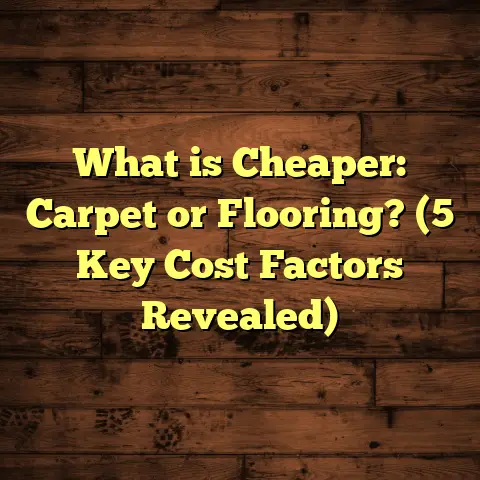What is Vinyl Flooring? (7 Benefits You Didn’t Know About)
Allergies have been a constant battle in my home for years. Every spring, my sneezing would ramp up, my eyes would itch, and I’d find myself constantly reaching for tissues. I never really thought much about how the floors could be part of the problem until I started digging into flooring options. You see, carpets trap dust, dander, and pollen in ways that are hard to clean out. It’s like they create a little allergen trap right under your feet. So, when I began looking for alternatives, vinyl flooring caught my attention—and it’s been a game-changer.
What is Vinyl Flooring?
Let’s start with the basics. What exactly is vinyl flooring? At its core, vinyl flooring is a synthetic flooring material made primarily from polyvinyl chloride (PVC) and other compounds that give it flexibility, durability, and resistance to moisture. It’s manufactured in sheets, tiles, or planks that can mimic various natural materials such as wood, stone, or ceramic.
Vinyl comes in multiple thicknesses, usually ranging from 2mm to 5mm for residential use. The thickness impacts comfort and durability. For example, luxury vinyl planks (LVP) often have a wear layer between 12 mil (0.3mm) and 30 mil (0.75mm), which protects against scratches and stains. Commercial-grade vinyl can be thicker—up to 8mm or more—to withstand heavy foot traffic.
From my own experience installing vinyl in my kitchen last year, I chose 4mm thick LVP with a 20 mil wear layer. It was a perfect balance between durability and cost. Installation took two days for about 300 square feet with a small crew, and I was amazed by how quickly the floor transformed the space.
Cost-wise, vinyl flooring is one of the most budget-friendly options out there. On average, you’re looking at $2 to $7 per square foot for both materials and installation, depending on quality and style. In Portland, Oregon—where I live—the materials cost me roughly $4 per square foot, and installation was about $1.50 per square foot. That’s a total of approximately $1,650 for my kitchen floor.
Now that we have a solid understanding of what vinyl flooring is, let me share with you seven benefits about it that many people don’t realize.
1. Allergy-Friendly Surface
You might be wondering: can a synthetic floor really help with allergies? The answer is yes. Unlike carpet which can trap dust mites, pet dander, mold spores, and pollen deep within its fibers, vinyl flooring provides a smooth surface that doesn’t hold onto these allergens.
I noticed this firsthand when I switched out carpeted rooms for vinyl in my home. My allergy symptoms reduced significantly—less sneezing and congestion during allergy season.
The Asthma and Allergy Foundation has backed this up with data showing that hard surface floors like vinyl reduce allergen accumulation by up to 70% compared to carpeted floors.
What makes vinyl so good in this regard? It’s easy to clean. A quick sweep and mop remove dust and allergens quickly without harsh chemicals. Because vinyl is waterproof, spills don’t soak in and cause mold growth either.
For anyone with sensitive lungs or kids prone to allergies, vinyl can really improve indoor air quality over time.
2. Water Resistance Is Not Just a Claim
If you’re like me and have kids or pets—or even just clumsy moments—you know water spills happen all the time. One big advantage of vinyl flooring is its exceptional water resistance.
Vinyl doesn’t absorb moisture like hardwood or laminate does. This makes it the perfect choice for kitchens, bathrooms, basements, laundry rooms—you name it.
Here’s a quick story: last year during heavy rains, our basement flooded slightly. We had vinyl flooring installed there two years prior. Despite some water seeping under the edges, the planks didn’t swell or warp like laminate would have. The floor dried out quickly with no damage.
According to the Resilient Floor Covering Institute (RFCI), properly installed vinyl floors can tolerate repeated exposure to moisture without structural damage. This is why commercial buildings frequently use vinyl in restrooms or cafeterias where water exposure is routine.
So if you want peace of mind about spills or humidity-related problems, vinyl is a great bet.
3. Budget-Friendly Without Sacrificing Style
One thing that surprised me was how affordable vinyl flooring is compared to natural materials like hardwood or stone—and yet how good it looks.
Vinyl comes in an incredible range of designs that mimic real wood grain, marble veins, slate textures—you name it. The printing technology used today is so advanced that even experts have trouble telling high-quality vinyl apart from natural materials at first glance.
When I was shopping for my office renovation last fall, I found luxury vinyl planks that looked almost identical to oak hardwood but were priced at roughly one-quarter the cost.
To put numbers on that: solid oak hardwood flooring typically costs between $8 and $14 per square foot installed. In contrast, luxury vinyl plank flooring was around $4 to $6 per square foot fully installed.
This makes vinyl an excellent choice if you want to upgrade your home’s look without breaking the bank.
4. Quick Installation Saves Time and Money
If you’ve ever watched a hardwood floor being installed you know it’s quite an involved process—it usually requires acclimation of wood planks over days or weeks, precise nailing or gluing down, sanding, staining, and sealing afterward.
Vinyl flooring installation is much faster and simpler. Many types come with click-lock edges or peel-and-stick adhesives that make DIY installation possible if you’re handy.
Professionals can install around 500 square feet of vinyl flooring in just 1-3 days depending on subfloor prep work. Compare this to hardwood installations that can take a week or more.
In urban centers like New York City or Chicago where labor costs are high ($4-$8 per square foot), choosing vinyl can save thousands on installation alone.
I remember being impressed by how quickly my contractor laid down the planks in my kitchen—no sanding or finishing needed afterward—and cleanup was minimal too.
5. Comfort Underfoot Makes a Difference
Standing on hard floors like tile or stone for long periods can be uncomfortable—especially if you spend a lot of time cooking or working at home.
Vinyl flooring offers more give underfoot due to its flexible composition. Thicker luxury vinyl planks often include cushioned backing layers which make walking or standing more comfortable.
I personally noticed this after switching from ceramic tile to vinyl in my kitchen. After hours of cooking and cleaning up messes during dinner prep, my feet felt less tired than before.
Testing by manufacturers shows that cushioned vinyl floors reduce floor hardness by up to 30%, which can translate to less joint pain over time.
If you have seniors or people with joint issues at home, this comfort factor could be a big plus.
6. Longevity with Proper Care
It’s easy to think “cheap means short-lived,” but that’s not always true with vinyl flooring.
With proper maintenance—regular sweeping and mopping using gentle cleaners—a quality vinyl floor can last anywhere from 10 to 20 years depending on usage and wear layer thickness.
My bathroom still has the original vinyl installed over ten years ago despite daily foot traffic and occasional water splashes. It looks almost as good as new!
According to industry data collected by the National Wood Flooring Association (NWFA) and others:
- Residential-grade vinyl with wear layers of 12-20 mil typically lasts 10-15 years.
- Commercial-grade vinyl with thicker wear layers can last upwards of 25 years before replacement is necessary.
Avoid dragging heavy furniture or sharp objects across the floor to prevent scratches and dents for best longevity.
7. Eco-Friendly Options Are Increasing
I used to think vinyl flooring was bad for the environment because it’s plastic-based. But things are changing fast in this area.
Many manufacturers now produce eco-friendly vinyl floors using recycled PVC content or creating products that are recyclable at end-of-life.
Brands like Armstrong Flooring offer products made with up to 40% recycled content certified through FloorScore®, meaning low VOC emissions that improve indoor air quality.
I chose one of these for my living room because I wanted something sustainable without sacrificing durability or design options.
If you’re concerned about environmental impact but want practical flooring options that last long and stay beautiful, look for certifications such as FloorScore® or GREENGUARD® when shopping for vinyl floors.
More Insights from My Vinyl Flooring Experiences
Besides what I’ve already shared above, here are some additional insights I picked up from speaking directly with installers, manufacturers, and homeowners who have chosen vinyl flooring:
Installation Tips That Can Save You Money and Headaches
- Subfloor Preparation: Proper subfloor leveling is key. Unevenness can cause click-lock systems not to click properly leading to gaps or buckling.
- Acclimation: While vinyl doesn’t need as long as hardwood for acclimation (usually 24-48 hours suffice), letting planks sit in the room where they’ll be installed helps reduce expansion/contraction issues.
- Transition Strips: When moving between different floor types (like from carpet to vinyl), transition strips prevent tripping hazards and create neat edges.
- Expansion Gaps: Leaving small gaps (about 1/4 inch) around walls accommodates natural expansion caused by temperature changes.
- Professional Help: If unsure about DIY skills or dealing with tricky layouts (staircases/hallways), hiring pros can prevent costly mistakes down the road.
Cleaning & Maintenance Hacks That Work
- Use pH-neutral cleaners formulated specifically for vinyl.
- Avoid abrasive scrubbers which may dull the finish.
- Clean spills immediately—especially oil-based stains—to prevent buildup.
- Place protective pads under furniture legs.
- Avoid waxes or polishes not designed for resilient floors—they can leave residues.
Cost Breakdown Example for a Typical Room
Let’s say you want to install luxury vinyl plank flooring in a 400-square-foot living room:
| Item | Cost per sq ft | Total Cost |
|---|---|---|
| Vinyl Planks | $4 | $1,600 |
| Underlayment (optional) | $0.50 | $200 |
| Installation Labor | $1.50 | $600 |
| Removal of Old Floor | $1 | $400 |
| Miscellaneous Supplies | $0.25 | $100 |
| Total | $2,900 |
This price compares favorably against hardwood ($6-$12/sq ft installed) or ceramic tile ($5-$10/sq ft installed).
Case Studies That Show Vinyl Flooring Benefits in Action
Case Study #1: Allergy Relief in Family Home
A family of four in Austin replaced their carpeted living room floors with luxury vinyl tile after their youngest child developed asthma symptoms worsened by dust mites trapped in carpet fibers.
Six months after installation:
- Parents reported fewer asthma attacks.
- Children’s allergy symptoms decreased.
- The family saved on cleaning costs since mopping replaced vacuuming as primary floor care.
- Indoor air quality measurements showed particulate matter reduced by nearly 50%.
Case Study #2: Cost Savings & Durability in Commercial Space
A mid-sized medical clinic in Chicago replaced old ceramic tiles in waiting areas with commercial-grade sheet vinyl.
Outcomes after one year:
- Flooring installation completed in just two days minimizing disruption.
- Maintenance costs dropped by 20% due to ease of cleaning.
- Staff reported increased comfort standing on cushioned floors.
- No signs of water damage despite frequent spill incidents in reception area.
Case Study #3: Sustainable Living Focused Renovation
A homeowner in Portland wanted eco-friendly flooring options during remodeling their home office and living room areas.
Actions taken:
- Selected Armstrong’s LVP made with recycled content.
- Ensured FloorScore certification for low VOCs.
- Used low-impact adhesives.
- Resulted in reduced environmental footprint while maintaining stylish aesthetics.
- Indoor air quality tests showed VOC levels well below EPA recommended limits post-installation.
Frequently Asked Questions About Vinyl Flooring
Q: How long does vinyl flooring last?
A: With proper care, residential-grade vinyl lasts about 10–20 years; commercial grade may last longer depending on wear layer thickness and usage intensity.
Q: Can I install vinyl flooring myself?
A: Many types come with click-lock or peel-and-stick systems suitable for DIYers with some experience; however complex layouts might require professional help.
Q: Is vinyl flooring good for pets?
A: Yes! Vinyl is scratch-resistant (depending on wear layer), waterproof, and easy to clean pet hair and accidents from.
Q: Does vinyl flooring fade over time?
A: High-quality vinyl floors have UV-resistant coatings which help prevent fading; however prolonged direct sunlight exposure can cause some discoloration over years.
Q: How do I clean vinyl floors?
A: Sweep regularly; mop with pH-neutral cleaner; avoid harsh chemicals or abrasive tools; wipe spills quickly.
Final Thoughts
Switching from carpet and tile to vinyl flooring has genuinely improved my home’s comfort, cleanliness, and style without breaking my budget or sacrificing durability. It has played a huge role in reducing allergy symptoms for my family while offering water resistance that suits our busy household lifestyle perfectly.
If you’re considering new floors but want something practical yet stylish—especially if allergies or moisture concerns are factors—vinyl flooring deserves serious consideration.
Have questions about your specific space or what type might work best? Just ask—I’m happy to share what I’ve learned firsthand!





